Function Continuously Approaching a Limit of Zero
| | Math 121 - Calculus for Biology I | |
|---|---|---|
| San Diego State University -- This page last updated 29-Apr-01 |
Limits, Continuity, and the Derivative
- Limits
- Continuity
- Derivative
- This is a theoretical section that studies the concepts of limits, continuity, and the derivative
- The definition of the derivative is presented
- This section sketches the formal mathematics needed for the derivative
- A complete understanding is beyond the scope of this course
- Earlier noted how the derivative is related to the slope of tangent line for a curve at a point
Limits
- Conceptually, the limit of a function f ( x ) at some point x 0 simply means that if your value of x is very close to the value x 0 , then the function f ( x ) stays very close to some particular value.
Definition: The limit of a function f ( x ) at some point x 0 exists and is equal to L if and only if every "small" interval about the limit L , say the interval ( L - e , L + e) , means you can find a "small" interval about x 0 , say the interval ( x 0 - d , x 0 + d) , which has all values of f ( x ) existing in the former "small" interval about the limit L , except possibly at x 0 itself.
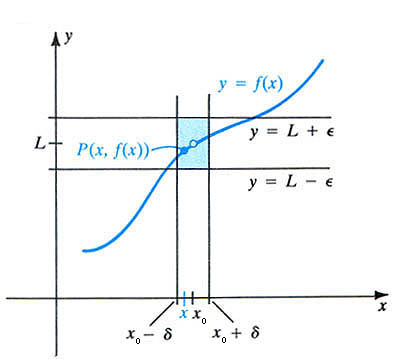
- This is a difficult concept to fully appreciate. However, you should be able to grasp the idea through several examples.
Examples:
1. f ( x ) = x 2 - x - 6
- Find the limit as x approaches 1
- From either the graph or from the way you have always evaluated this quadratic function that as x approaches 1, f ( x ) approaches -6, since f (1) = -6.
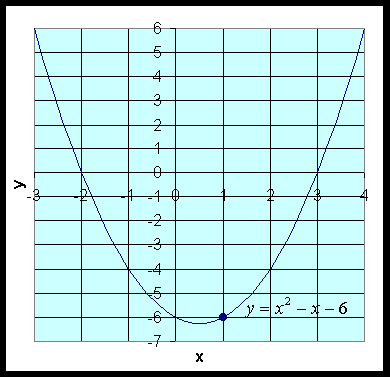
Fact: Any polynomial, p ( x ) , has as its limit at some x 0 , the value of p ( x 0 ) .
2. The rational function ![]()
- Find the limit as x approaches 1
- If x is not 3, then this rational function reduces to r ( x ) = x + 2
- So as x approaches 1, this function simply goes to 3.
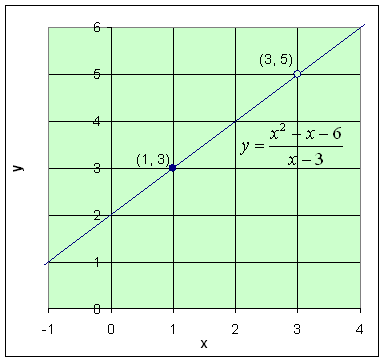
Fact: Any rational function, r ( x ) = p ( x )/ q ( x ) , where p ( x ) and q ( x ) are polynomials with q ( x 0 ) not zero, then the limit exists with the limit being r ( x 0 ) .
3. The rational function in Example 2.
- Find the limit as x approaches 3
- Though r ( x ) is not defined at x 0 = 3, arbitrarily "close" to 3, r ( x ) = x + 2
- So as x approaches 3, this function goes to 5
- Its limit exists though the function is not defined at x 0 = 3.

4. Consider the rational function f ( x ) = 1/ x 2
- Find the limit as x approaches 0, if it exists
- This function has a limit for any value of x 0 where the denominator is not zero
- However, at x 0 = 0, this function is undefined
- Thus, the graph has a vertical asymptote at x 0 = 0
- This means that no limit exists for f ( x ) at x 0 = 0
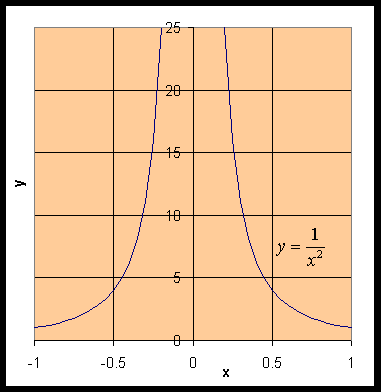
Fact: Whenever you have a vertical asymptote at some x 0 , then the limit fails to exist at that point.
5. The rational function ![]()
- Find the limit as x approaches 3, if it exists
- This function has a limit for any value of x 0 where the denominator is not zero
- However, at x 0 = 3, this function is undefined
- The function is not approaching zero in the numerator near x 0 = 3
- Thus, the graph would show a vertical asymptote at x 0 = 3
- This means that no limit exists for r ( x ) at x 0 = 3

6. The Heaviside function is often used to specify when something is "on" or "off." The Heaviside function is defined as

- This function clearly has the limit of 0 for any x < 0, and it has the limit of 1 for any x > 0
- Even though this function is defined to be 1 at x = 0, it does not have a limit at x 0 = 0
- If you take some "small" interval about the proposed limit of 1, say e = 0.1 , then all values of x near 0 must have H ( x ) between 0.9 and 1.1
- But take any "small" negative x and H ( x ) = 0, which is not in the desired given interval
- Thus, no limit exists for H ( x )
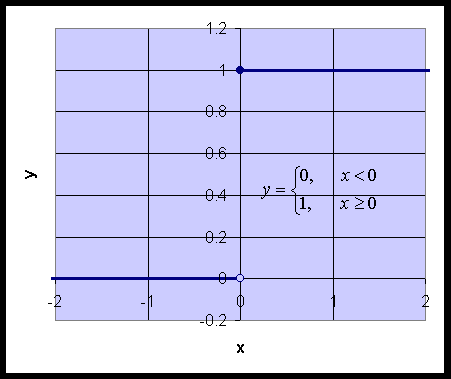
Perspective: Whenever a function is defined differently on different intervals in a manner similar to the Heaviside function above, you need to check the places where the function changes in definition to see if the function has a limit at these x values where the function changes. (It might also have asymptotes at other points where again you would check.)
7. The fractional power function f ( x ) = x 1/2
- Find the limit as x approaches 0, if it exists
- This function is not defined for x < 0, so it cannot have a limit at x = 0, though it is said to have a right-handed limit
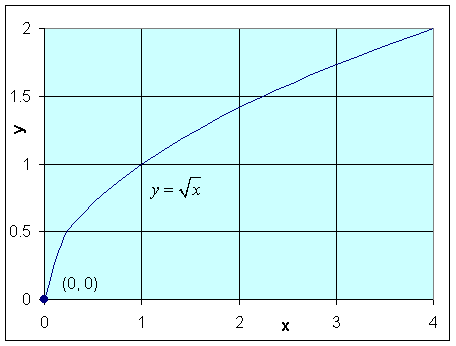
Summary of Limits: Most of the functions that you regularly examine have limits. Usually, the problems arise at points x 0 when there is a vertical asymptote, the function is defined differently on different intervals, or special cases like the square root function.
Continuity
- Closely connected to the concept of a limit is that of continuity
- Intuititvely, the idea of a continuous function is what you would expect
- If you can draw the function without lifting your pencil, then the function is continuous
- Most practical examples use functions that are continuous or at most have a few points of discontinuity
Definition: A function f ( x ) is continuous at a point x 0 if the limit exists at x 0 and is equal to f ( x 0 ).
- The examples above should also help you appreciate this concept
- In all of the cases except Example 3, the existence of a limit also corresponds to points of continuity
- Example 3 is not continuous at x 0 = 3 though a limit exists here, as the function is not defined at 3
- Examples 3 and 5 are discontinuous only at x 0 = 3
- Examples 4, 6 and 7 are discontinuous only at x 0 = 0
- At all other points in the domains of these examples are continuous.
Example Comparing Limits and Continuity
- An example is provided to show the differences between limits and continuity
- Below is a graph of a function, f (x), that is defined on the interval [-2, 2], except at x = 0, where there is a vertical asymptote
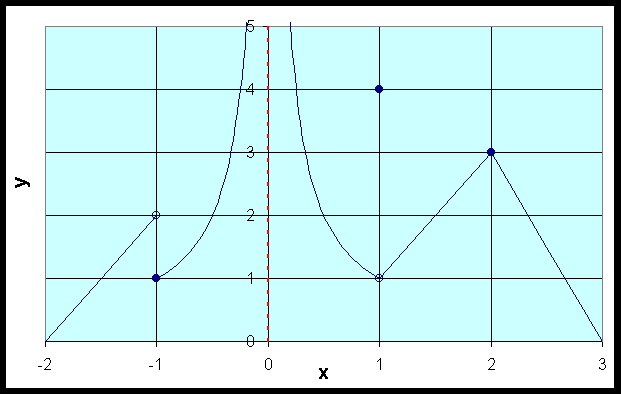
- The difficulties with this function occur at integer values
- At x = -1, the function has the value f (-1) = 1
- It is clear that the function is not continuous nor does a limit exist at this point
- At x = 0, the function is not defined (not continuous nor has any limits) as there is a vertical asymptote
- At x = 1, the function has the value f (1) = 4
- The function is not continuous at x = 1, but the limit does exist with
![]()
- At x = 2, the function is continuous with f (2) = 3, which also means that the limit exists
- At all non-integer values of x the function is continuous (hence its limit exists)
Derivative
- The primary reason for the discussion above is for the proper definition of the derivative
- In the previous sections, we noted that the derivative at a point on a curve is the slope of the tangent line at that point
- This motivation is what underlies the definition given below
Definition: The derivative of a function f ( x ) at a point x 0 is denoted by f ' ( x 0 ) and satisfies

provided this limit exists.
Examples:
1. Let us use this definition to find the derivative of f ( x ) = x 2 .

2. We repeat this computation to find the derivative of f ( x ) = 1/( x + 2) (for x not equal to -2).

- Clearly, we do not want to use this formula every time we need to compute a derivative
- The next section gives much easier formulae for finding derivatives
- Another very easy way to find derivatives is using the Maple diff command
Source: https://jmahaffy.sdsu.edu/courses/s00a/math121/lectures/limits_cont_deriv/limitsx.html
0 Response to "Function Continuously Approaching a Limit of Zero"
Post a Comment